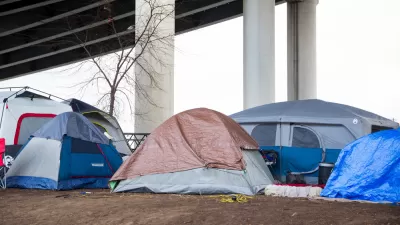Last week the Los Angeles City Council and Santa Clara County Board of Supervisors approved housing initiatives. "Build Better LA" requires large developments to have affordable units. Silicon Valley voters will vote on a $950 million housing bond.
Responding to the housing crisis in California, the council and board voted on the same day, June 21, to ask voters in their respective jurisdictions to address the problem by voting to increase the supply of affordable housing, though in very different ways.
The Los Angeles City Council voted 13-1 to place the "Build Better LA" Affordable Housing and Development Initiative on the November ballot, writes Dennis Romero for LA Weekly. The measure was originally unveiled by a coalition of labor unions and housing advocates last February.
"If approved, the measure would require developers to include affordable housing units in large projects for which they seek special permission to skirt zoning codes or to build beyond density and height restrictions," writes Elijah Chiland for Curbed Los Angeles.
It would also require that 30 percent of construction workers on these projects be hired locally, and that 10 percent be from areas where the median income is under $40,000. Or, developers could avoid the affordable housing rule altogether by electing to pay a fee instead.
A policy summary [PDF] includes additional requirements as they relate to Transit Oriented Communities, Affordable Housing Trust Fund, Parking, and Density Bonus. According to the summary, the initiative "[w]ould ensure that parking requirements can be reduced for projects that include affordable housing and job standards, thus ensuring the integrity of the density bonus program."
The city housing initiative will appear on the ballot with what amounts to a half-cent county transportation sales tax measure.
As posted last March, proponents of a competing housing measure to restrict large developments, the "Neighborhood Integrity Initiative," are aiming for the March 2017 ballot.
About 400 miles north of Los Angeles, the five-member Board of Supervisors of Santa Clara County unanimously voted to place a 30-year, $950 million affordable housing bond before voters in northern California's most populous county.
“For the first time in recent memory, voters see the most important problem facing Santa Clara County as housing,” [Supervisor Cindy Chavez, a cosponsor of the measure said in a press release]. “We have nearly five thousand people living on our streets and in our creeks, and the housing for them does not exist. This is why this bond measure is essential.”
[T]he $950 million General Obligation Bond would not affect the County’s General Fund, but would raise property taxes based on the value of the property for tax purposes. The owner of a home valued at $500,000 by the Tax Assessor’s Office, for example, would pay $12.66 per $100,000 of assessed valuation, or $63.30 a year more in property taxes.
Funds would be allocated to housing meant for various levels of median income levels, including "up to $50 million for Moderate Income residents who are first-time homebuyers."
"The majority of the funds -- $750 million -- would go toward those considered to be in the 'extremely low income' category, often meaning homeless or on the verge of being homeless," writes Eric Kurhi in The Mercury News
The measure will need to pass by a two-thirds margin because the funds are targeted for specific purposes, as was not the case with a June sales tax measure in San José, the county seat, that passed with 61 percent of the vote.
The property tax measure will appear on the county ballot with a half-cent sales tax measure to extend BART under San Jose to the Santa Clara Caltrain Station.
In addition, as posted earlier this month, San Francisco voters will decide on initiatives that deal with increasing heights for affordable housing, legalizing construction of inlaw (accessory dwelling) units, and removal of tent encampments.
FULL STORY: Housing Initiatives to Appear on Northern and Southern California Ballots in November

Planetizen Federal Action Tracker
A weekly monitor of how Trump’s orders and actions are impacting planners and planning in America.

Maui's Vacation Rental Debate Turns Ugly
Verbal attacks, misinformation campaigns and fistfights plague a high-stakes debate to convert thousands of vacation rentals into long-term housing.

Cuomo Is the Candidate of Both NIMBYs and Developers. What Gives?
In the New York City mayoral race, odd bedfellows align to preserve the housing status quo.

Amtrak Rolls Out New Orleans to Alabama “Mardi Gras” Train
The new service will operate morning and evening departures between Mobile and New Orleans.

The Subversive Car-Free Guide to Trump's Great American Road Trip
Car-free ways to access Chicagoland’s best tourist attractions.

San Antonio and Austin are Fusing Into one Massive Megaregion
The region spanning the two central Texas cities is growing fast, posing challenges for local infrastructure and water supplies.
Urban Design for Planners 1: Software Tools
This six-course series explores essential urban design concepts using open source software and equips planners with the tools they need to participate fully in the urban design process.
Planning for Universal Design
Learn the tools for implementing Universal Design in planning regulations.
Heyer Gruel & Associates PA
JM Goldson LLC
Custer County Colorado
City of Camden Redevelopment Agency
City of Astoria
Transportation Research & Education Center (TREC) at Portland State University
Jefferson Parish Government
Camden Redevelopment Agency
City of Claremont




























